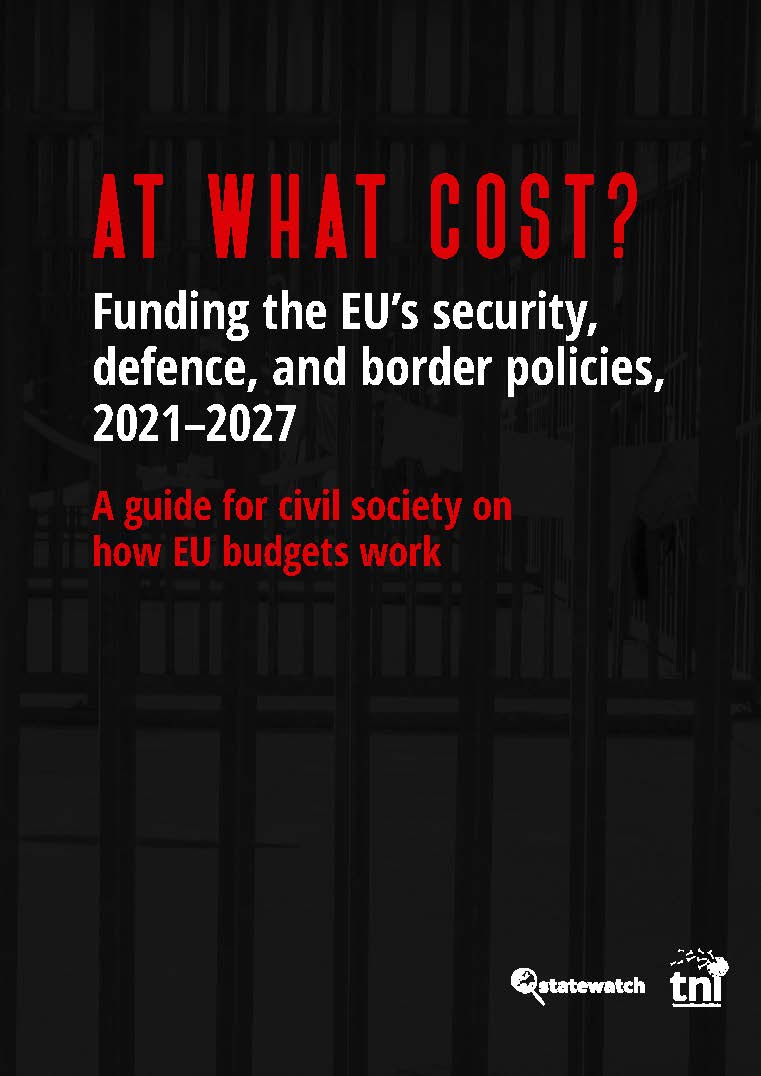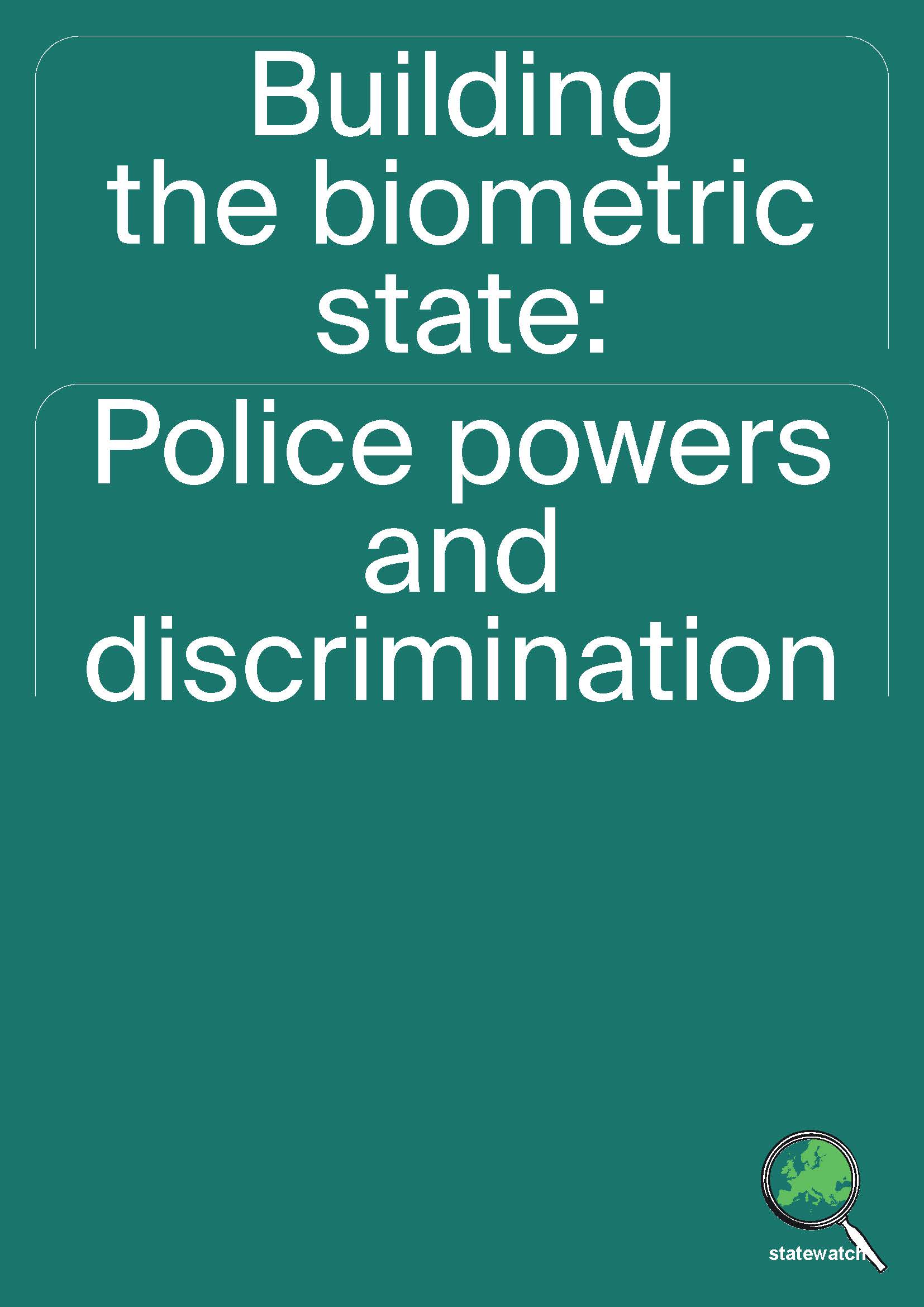At what cost? Funding the EU’s security, defence, and border policies, 2021–2027
Topic
Country/Region
03 May 2022
A critical guide for civil society on how EU budgets work. Co-published with the Transnational Institute.
Support our work: become a Friend of Statewatch from as little as £1/€1 per month.
Download the report as a PDF of read it online at the Transnational Institute website.
At time time of writing, a war is being waged in Ukraine following an illegal invasion by Russian troops in February 2022. In response to this war, European Commission president, Ursula von der Leyen, announced that the EU would, for the first time ever, finance the purchase and delivery of weapons to a country under attack. EC vice president and high representative for foreign affairs and security policy, Josep Borrell, confirmed that lethal weapons would be sent to the war zone, funded by the European Peace Facility, saying that ‘another taboo has fallen… that the European Union was not providing arms in a war’.
The European Peace Facility is but one of the EU’s array of budgetary instruments that form part of the 2021–27 Multi-annual Financial Framework (MFF), under which an unprecedented amount of money has been earmarked for security and defence purposes. Other instruments with specific budget lines for security, defence and military equipment include the Internal Security Fund (ISF), the Integrated Border Management Fund (IBMF), the Asylum and Migration Fund (AMF), the Security Research Programme and the European Defence Fund (EDF), among others. This research discusses the objectives and functioning of each of these instruments, while also interrogating the larger political picture regarding what their approval means for the EU as a whole.
This report reveals that:
The 2021–27 Multi-annual Financial Framework allocates an unprecedented amount of European public money for security and defence purposes, more than doubling its budget from one spending cycle to the next.
- The overall amount of money earmarked for security and defence spending is €43.9 billion, an increase of more than 123% when compared to the previous seven-year budgetary cycle, which allocated €19.7 billion for the same purpose.
- The largest increase from the previous budgetary cycle can be seen in the European Defence Fund, which replaces its precursor programmes (Preparatory Action on Defence Research and European Defence Industrial Development Programme) with a massive funding increase of 1256%, to reach a total of almost €8 billion. This money will, for the first time, be used for the research and development of high-tech military weaponry.
- The European Peace Facility, which may be understood as replacing the Athena mechanism and African Peace Facility, will increase its budget by 119% to €5.7 billion. This means that 31% of the overall spending will go on military weaponry research and development and an off-budget military initiative with almost no democratic scrutiny, oversight or transparency whatsoever.
- Other significant budget hikes include the Internal Security Fund, which will increase by 90% to €1.9 billion, the Integrated Border Management Fund – Border and Visa, which will increase by 131% to €6.2 billion and the funds being made available to agencies such as Frontex and Europol, which will increase by 129% to €9.6 billion. The increase of the Asylum and Migration Fund is less notable at 43% but the instrument will still receive a substantial €9.9 billion.
- The Citizens, Equality, Rights and Values Programme will increase its budget by 124%, to reach €1.4 billion, but this figure should be put in to context – it pales in comparison to the €43.9 billion being invested in militarised security and defence initiatives. Funding for law enforcement, border control, military research and development and operations (€43.9bn) is 31 times higher than funding for rights, values and justice (€1.4bn). Furthermore, the majority of the latter funds will still be awarded to states rather than independent organisations.
In addition to the aforementioned funds, development aid will be redirected towards border management and will play an increased role in enhancing non-EU states’ ability to control migratory movements. The European Development Fund and EU Trust Fund for Africa have both been used to pursue migration policy objectives, and in the 2021–27 period 10% of the new €79 billion Neighbourhood, Development and International Cooperation Instrument (NDICI) ‘should be dedicated particularly to actions supporting management and governance of migration and forced displacement within the objectives of the Instrument’.
The massive increase in security spending will also strengthen ‘Fortress Europe’ and further the long-standing goal of the EU and its member states to externalise border control to third countries regardless of these policies’ devastating consequences. The objective of containing unwanted people fleeing war and persecution outside Europe’s borders has been strongly prioritised in the 2021–27 security and migration funds:
- The new home affairs fund seeks to enhance the ability of countries outside the EU to control migration and one of the main objectives of the AMF is centred on the external dimension of asylum and migration management.
- One aim of the IBMF is ‘to facilitate legitimate border crossings, to prevent and detect illegal immigration and cross-border crime and to effectively manage migratory flows’, and one of the ways in which this can be done is through ‘the enhancement of inter-agency cooperation’ between member states, Union bodies and third countries.
- The IBMF will finance the deployment of immigration liaison officers to third countries to gather information and intelligence on migratory movements. Frontex, the EU’s border and coast guard agency, has its own pool of liaison officers who undertake similar work.
- The consequences of border externalisation policies are felt in regions as far south as the Sahel or as far east as countries neighbouring Afghanistan, where immigration and asylum authorities have, in effect, become the border guards of the EU, detaining and containing those on the move in search of safety.
The European Defence Fund and the European Peace Facility mark a new point of departure for the EU in pivoting towards hard power and militarism.
- The European Peace Facility (EPF) is an off-budget fund which will circumvent, and may eventually render redundant, EU rules against funding military projects. Under the EPF lethal weapons may be provided to third countries for defence purposes. The financing and provision of weapons to Ukraine is the first such example.
- The European Defence Fund (EDF) will, for the first time, provide funding for the research and development of high-tech military equipment, which until now was largely prohibited by the EU.
- A substantial amount of funding will also bolster the European security industrial complex and serve to subsidise the already highly lucrative homeland security industry. This complex has long promoted a vision of security based on the development and deployment of technical ‘solutions’, many of which are premised on novel and enhanced surveillance techniques.
- The lion’s share of EU funding for homeland security research has long gone to private companies that are likely to continue being the main beneficiaries of these funds in the 2021–27 period.
- The European Defence Fund will provide a new source of finance for many of the same corporations that have been significant recipients of security research funding. There is a requirement for the European Commission and other actors to ensure ‘synergies’ between the two programmes, and to exploit dual-use technology that may be of use to both the homeland security and military sectors. In practice, this is likely to mean the further militarisation of the civil sphere and the continuation of the long-standing trend to blur the lines between war, policing and internal security initiatives.
- The significance of the EPF and EDF for the EU as a political project should not be underestimated. The creation of these funds marks a new point of departure for the EU, which began as a peace project. Under these funds it is actively shifting course and is now pursuing militarised objectives.
- Determining the priorities of these funds will remain matters of state – apart from a limited role in negotiating legislation, the role of the European Parliament and civil society after laws have been passed is severely restricted, raising serious questions regarding parliamentary and public scrutiny, transparency and oversight.
The EU’s Border and Coast Guard Agency, Frontex, will be provided with unprecedented funding of €5.6 billion from 2021-2027, a 194% increase compared to the previous budgetary cycle, and a key role in overseeing member states’ use of EU migration funds.
- While Frontex received €6 million in 2005, it now receives an average of €800 million a year – a 13,200% increase in budget over less than 20 years.
- The agency will receive several hundred million euros a year to fulfil its expanded role, and in particular to develop its ‘standing corps’ of 10,000 border guards.
- The European Commission is obliged to take into account Frontex’s views on national spending using the AMF and IBMF, and the agency is to be consulted on how member states should address recommendations resulting from evaluations on how they manage their borders.
- Any equipment purchased by national border authorities using the IBMF must meet Frontex’s technical standards, and be made available for use by the agency.
- Frontex is to play a key role in identifying and evaluating relevant research activities as part of the Civil Security for Society homeland security research programme
Although the funding is being allocated for activities that carry significant risk, such as research into and development of lethal weapons, intrusive surveillance and policing, or the reinforcement of deadly border control practices, transparency, oversight, and accountability are all sorely lacking:
- Although the EU’s new security funds will be subject to some measure of democratic scrutiny and oversight, and there will be some transparency regarding the projects and activities funded, this is largely restricted to the provision of information on spending and results, while democratic participation in setting priorities is strictly limited. With regard to the ISF, the European Commission is obliged to compile reports, to which the Parliament can then propose recommendations, which the Commission ‘shall endeavour to take into account’. There is no such requirement however, for the AMF or IBMF.
- For the most part, it will be state officials in EU member states who determine how these funds are spent, while elected representatives and civil society organisations have only been granted a post-facto oversight role with no capacity to opine or influence spending beforehand.
- There are a number of loopholes for the home affairs funds that could be used to inhibit transparency and, in turn, accountability. National authorities are obliged to publish information on the AMF, IBMF and ISF, ‘except where Union law or national law excludes such publication for reasons of security, public order, criminal investigations, or protection of personal data’ – in the hands of over-zealous officials, ‘security’ and ‘public order’ could be interpreted very broadly as a means of restricting public access.
- Transparency has been kept to an absolute minimum with regard to the European Defence Fund and European Peace Facility.
- The distribution of spending on external migration policies across different funding streams (such as development, migration, and security) means that political responsibility is distributed and diluted, further reducing the Parliament’s capacity to exert democratic scrutiny and oversight.
What is notable by its absence from the 2021–2027 Multi-annual Financial Framework?
- There is no funding to undertake search and rescue operations in the Mediterranean, but rather to provide assistance or actively participate in ‘push or pull back’ operations to prevent migrants and asylum seekers from reaching Europe’s shores.
- There are only limited requirements to consult the EU’s own expert body on fundamental rights, the Fundamental Rights Agency, when drafting and approving spending programmes, while there is no obligation whatsoever to consult the European Institute for Gender Equality or national human rights bodies.
- These funds attempt to address the consequences, and not root causes, of political and social conflict. For example, with regard to racism and xenophobia towards migrants and refugees, they appear to placate such sentiments rather than to find creative ways to effectively challenge them.
Our work is only possible with your support.
Become a Friend of Statewatch from as little as £1/€1 per month.
Spotted an error? If you've spotted a problem with this page, just click once to let us know.


